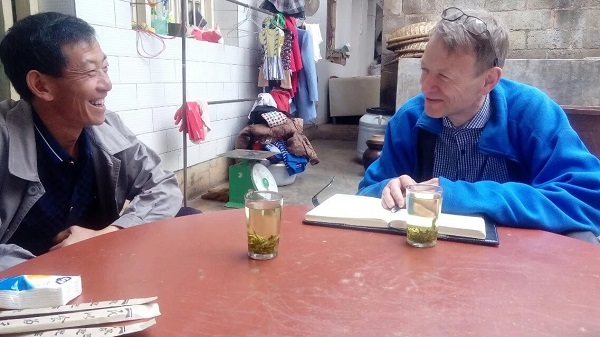Home \ Project News \ An Interview with the Project Leader for “Farmers’ Clubs” in Xundian County
Piloting Carbon Financing Development for Community Driven Climate Smart Agriculture in Yunnan is a project funded by Blue Moon Fund and is operating in Xundian Hui and Yi Autonomous County in Yunnan. It is one of several “Farmers’ Club” projects started by Humana People to People China. The name indicates that farmers are organized in groups and are themselves the driving force in the projects. The project in Xundian started on the 1st of January 2015 and is a three year program. The Climate Smart Agriculture Project is teaching farmer’s climate change adaptation strategies and advocates that they take action on reducing carbon emission. The project aims at improving the capacity of 400 farmers, local government institutions and other stakeholders for implementing and promoting sustainable agricultural land management and climate smart agriculture. The project aims as well at increasing household crop production and income and to explore how farmers can enter into the carbon market. It also advocates for the restoration of soil health and local ecology through crop diversification, inter-cropping and plowing down crop residues to increase soil carbon, thereby decrease the need for fertilizer.
Discussing the next steps in the Farmers’ Club Meeting
Project Leader for the “Farmers’ Club” project in Xundian Xiang Songjun tells what the project has done in helping the farmers to achieve positive results.
System of Rice Intensification planting system not only reduces the carbon emission in the air but increases the harvest
“Since the start of the project a lot has happened due to our efforts as project team. At first it was difficult to mobilize the farmers and also to make them understand the idea of Climate Smart Agriculture. But due to training by our project team and different experts (with who we cooperate) the farmers started to understand our objective. The training partly focused on helping the farmers develop their production, partly to understand the concept and practical elements of Climate Smart Agriculture. In 2015, the year the project started, we made the footwork for the big achievements we have made in 2016. This year we have had training about intercropping, which we can see, according to the harvest, has improved the production. The simple reason is that by planting 2 different crops together you are able to utilize the land better (for example by planting corn in two rows and use the space between the rows to plant beans). From the rice the farmers planted this year we estimate a harvest 28% higher than in 2014. This improvement, we believe, is due to farmers using the “System of Rice Intensification” (SRI), a method in which you don’t let the rice stay under water the full growing season as in traditional rice planting. But you apply a continuous alternating wet and dry water management cycle. Various training on improving rice planting - and active participation of farmers - contributed to this achievement. I would like to say that this year we also faced some challenges, but we managed to find solutions by involving a lot of people from Humana People to People Project Service Center in Kunming and from different experts. A big challenge this year consisted of measuring reduction of methane emission brought about by the method of SRI planting. In periods when the roots of rice are not covered with water, the emission of methane is supposed to decrease. The measurement of this takes place in the field, where small containers are placed in the planting areas. Air samples are then made every week and brought to the laboratory for testing.
One challenge was to find a reliable way to take tests in the field and bring them to the laboratory. Last year we used a testing tube for sampling, but as we didn’t have a reference method to compare with, we couldn’t know for sure if the result was reliable. Professor Gu Jianlong, an expert from Yunnan Academy of Scientific & Technical Information searched for other methods and found an existing “sampling bag”, which we this year introduced as a reference method to be used together with the testing tube. A hand held and cheaper device was also tried, but failed as unreliable.
Methane collected and transported with the new sampling-bag showed figures which indicate that it is more reliable than the testing tube. To make the figures even more reliable we used two different laboratories, one in Kunming as well as one in Beijing, to test the samples over a 3 month period. Sampling tests ended at the beginning of the harvest period and the analysis afterwards indicated that measured methane emission reduction equivalent to 295.6 ton CO2 was achieved.
What do the farmers say about all what the project has done:
Huang Zhiping having interview
A farmer Huang Zhiping has this to say: “We are happy because the project has taught us the good ways of planting rice. We were also taught how to plant green beans and also to use the residues from the beans as green manure. I am happy that the project gave us seed and also training on how to plant the seeds. It is also good that I saw many of my fellow farmers attend these training on how to plant rice.” 

This project is funded by Blue Moon Fund (www. bluemoonfund.org) and Humana People to People Baltic (www.humana.lt).
Content in this article reflects the views of the authors and not those of the funder.